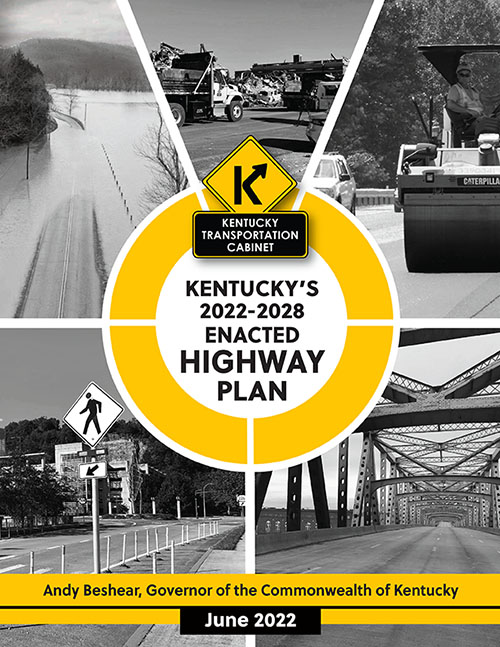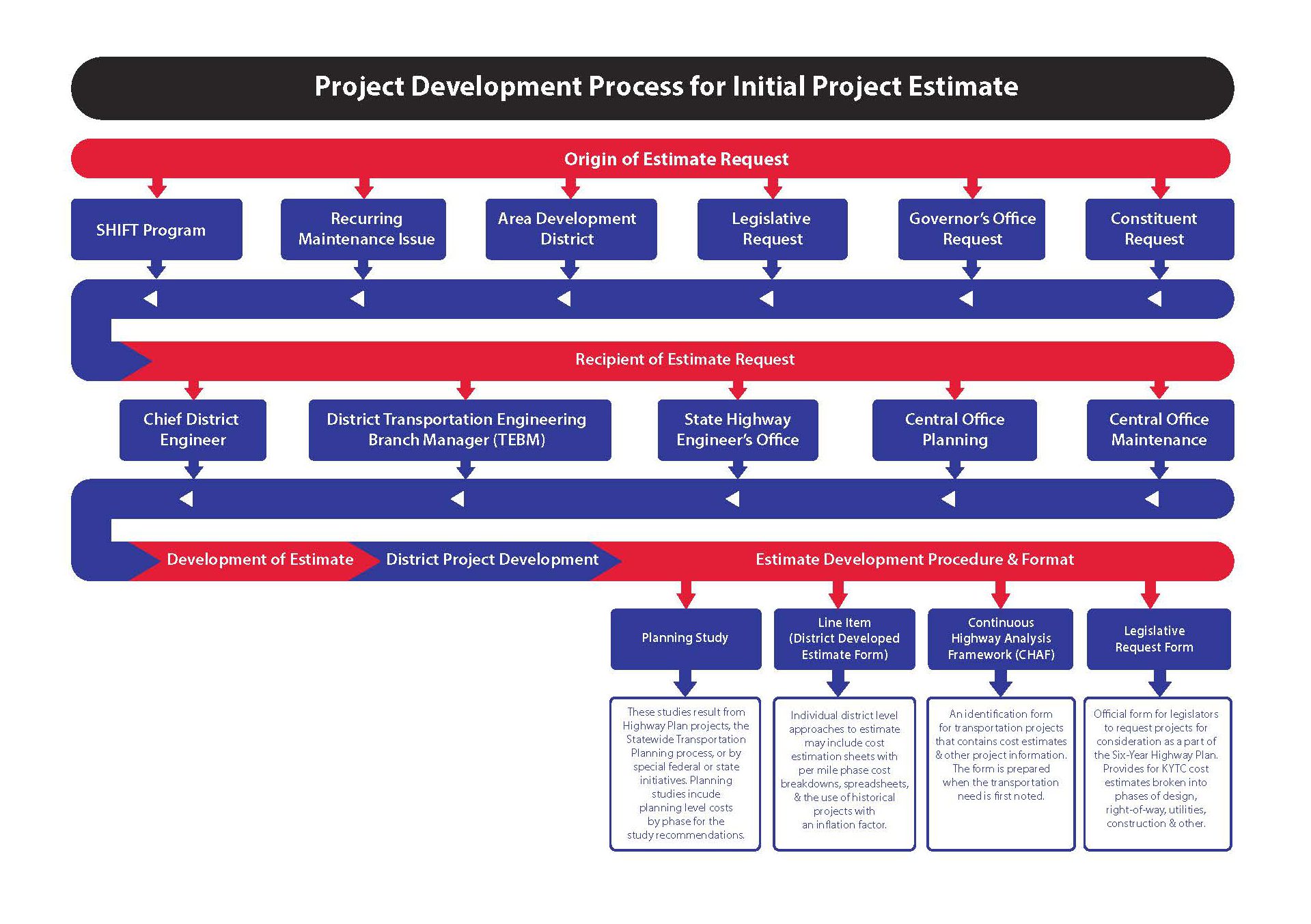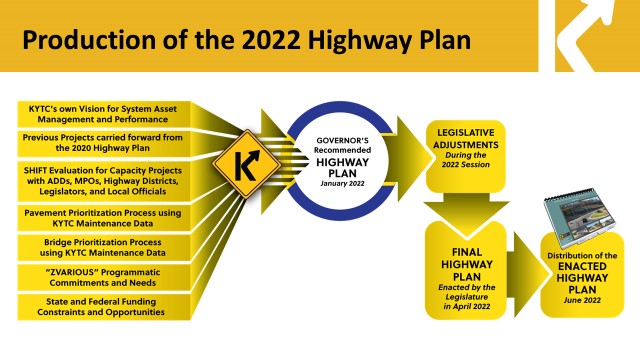Search for articles or browse our knowledge portal by topic.
Understanding the KYTC Budget and the Highway Plan

Source: KYTC Program Management website (https://transportation.ky.gov/Program-Management/Pages/default.aspx)
Understanding the KYTC Budget and the Highway Plan
| Understanding the KYTC Budget and the Highway Plan | Project Classification | |||
| Capital Improvement Projects | Safety Projects | Asset Management Projects | Maintenance Projects | |
| 1.0 Overview | x | x | x | |
| 2.0 Estimating the Project Budget | x | x | x | |
| 3.0 Highway Plan Funding | x | x | x | |
| 4.0 What is the Highway Plan? | x | x | x | x |
| 5.0 What Happens after the Highway Plan is Signed into Law? | x | x | ||
| x = Information from the topic may be applicable for the project classification. | ||||
The full definitions for terms included in this article (listed below) can be found in the HKP Glossary.
- Enacted Highway Plan
- Project
- Project Managers
In even-numbered years, the General Assembly approves a new Enacted Highway Plan, which the governor then signs into law. Each plan provides the framework for advancing transportation projectsA temporary endeavor undertaken to create a unique product, service, or result. Source: Project Management Institute. (2017). A Guide to the project management body of knowledge (PMBOK® guide) (6th ed.). during the upcoming two-year period (i.e., biennium) and lists recommended projects for the four-year period that follows the upcoming biennium. The plan contains a schedule for proposed projects as well as budgets for the planning, design, right-of-way, utility, and construction (PDRUC) phases.
Once a project appears in the biennium of the Enacted Highway Plan, funding may be authorized for designated phases. The plan also serves as a legislative tool to monitor highway project funds and schedules.
Projects in the Highway Plan are promises to their constituency and KYTC Project ManagersThe individual with the authority and responsibility for delivering the documented project scope and quality requirements within predictable time and budget targets. Source: Project Management Institute. (2017). A Guide to the project management body of knowledge (PMBOK® guide) (6th ed.). (PMs) are responsible for delivering projects to letting.
Before a project appears in the Enacted Highway Plan, an initial estimate must be prepared. This estimate provides a foundation for budgeting and establishes a baseline for future estimates. This process often occurs before a PM is assigned.
Initial estimates typically originate from the following sources:
- Planning study recommendations
- Continuous Highway Analysis Framework (CHAF) project estimates, usually prepared by District Project Development staff
- Legislative-requested estimates, usually prepared by District Project Development staff
Currently, KYTC District Offices use different methods to prepare initial estimates for each phase. For example, several use tailored spreadsheets and historical per-mile costs or other high-level estimating practices.
Initial cost estimates usually become the project budgets in the Enacted Highway Plan. Because the project budget is legislatively enacted, it is imperative that every effort is made to keep project costs within the budget. Exceeding a budget puts other projects at risk by reducing the limited amount of funds available for them. If the costs on one project increase, schedules and budgets for other projects listed in the Enacted Highway Plan can be directly impacted. As impacts accumulate, KYTC is forced to eliminate or delay projects to compensate for the cost increases.
Sometimes revising budgets is unavoidable. For example, in the following situations a PM may need to update an estimate so the budget can be revised:
- Approval of a scope change
- Prior to a new Enacted Highway Plan being adopted
- Upon request
A PM must inform the State Highway Engineer’s (SHE) Office of proposed changes that will impact costs and request authorization to make those changes. The request can occur during the quarterly review meeting, through the Location Engineer, or through direct communication with the SHE’s Office.
For more information on developing a project estimate and how estimates evolve throughout project development, see the PMGB article Project Cost Estimation and Management.
The Enacted Highway Plan funding is based on the most recent federal and state revenue estimates. Typically, the total value of projects for the six years covered in a plan ranges from $8 to $10 billion.
KYTC’s ability to provide federally-required state matching funds (typically 20% of the total project cost) and to undertake major projects that use only state funding is contingent on the amount of cash available in the Road Fund and requires the Cabinet to carefully manage Road Fund expenses. Fixed Cost Items (e.g., maintenance funding) do not appear in the Enacted Highway Plan.
The Enacted Highway Plan details how KYTC will spend taxpayer money on transportation project activities in the biennium. It is developed through the Cabinet’s transportation planning process and with input from elected officials, District Offices, Area Development Districts, and Metropolitan Planning Organizations (MPOs). The Plan includes the Biennial Construction Plan, which specifies funding available for authorization during the upcoming two-year period. It also lists project funding levels for the subsequent four-year period (referred to as Out Years). Out Year funding is not available for authorization. Including the Out Years helps to anticipate future funding needs and scheduling of project development and construction phases. Historically, funding estimates for these years have exceeded total annual budgets.
A new Enacted Highway Plan is developed and approved every two years during the legislative budget session. A plan typically goes through four iterations:
- The Governor’s Recommended Plan
- The House Plan
- The Senate Plan
- The Enacted Highway Plan
How is the HIGHWAY Plan Put Together?
For more information on how projects originate, including the SHIFT process and requesting funding authorization, see the PMGB article Project Initiation.
The Enacted Highway Plan includes:
- A narrative that explains how the plan was produced, revenue estimates and assumptions, details on current mega projects, and historical construction awards.
- An interpretive key that explains how to read individual project entries. Each entry contains high-level project information (e.g., county, route, description, item number) and indicates the amount of funding budgeted for each phase as well as the year(s) phases are budgeted.
- Lists of Existing Highway System Performance Projects, Highway Improvement Projects, and ZVARIOUS Projects.
KYTC’s Division of Program Management distributes the Enacted Highway Plan to project development staff once the governor signs it into law. The Division also updates the State Transportation Improvement Program (STIP). The new STIP incorporates federal projects found in the plan. To receive Federal-aid program funding, the STIP must be (1) fiscally constrained and (2) approved by the Federal Highway Administration (FHWA). The process of distributing the Enacted Highway Plan and updating the STIP usually takes several weeks.
Districts should coordinate with the SHE’s Office and the Division of Program Management to discuss and prioritize project funding authorizations. For more information on funding authorization, see the PMGB article Project Initiation.
Red Flag
It is not uncommon for projects that received funding in a previous Enacted Highway Plan to have funding for future phases deferred beyond the upcoming biennium or to be programmed with state funds, which are not fiscally constrained and rarely used for large authorizations.
Funding deferrals could result from the reprioritization of needs within the budget or changes in legislative representation. Since these projects cannot move to future phases without funding, the PM must find a good time to pause them. Options include a project delivery milestone (e.g., right-of-way plans) or a selected alternative with an approved Environmental Document. If these projects receive funding in the future, the PM determines whether project documents require updates. Environmental documents must be reevaluated prior to the project going into the next phase of development, and plans may require updates to ensure consistency with current standards.
Project Management Guide Book Knowledge Book:
Access the complete Knowledge Book here: Project Management Guidebook
Next Article: Project Identification




